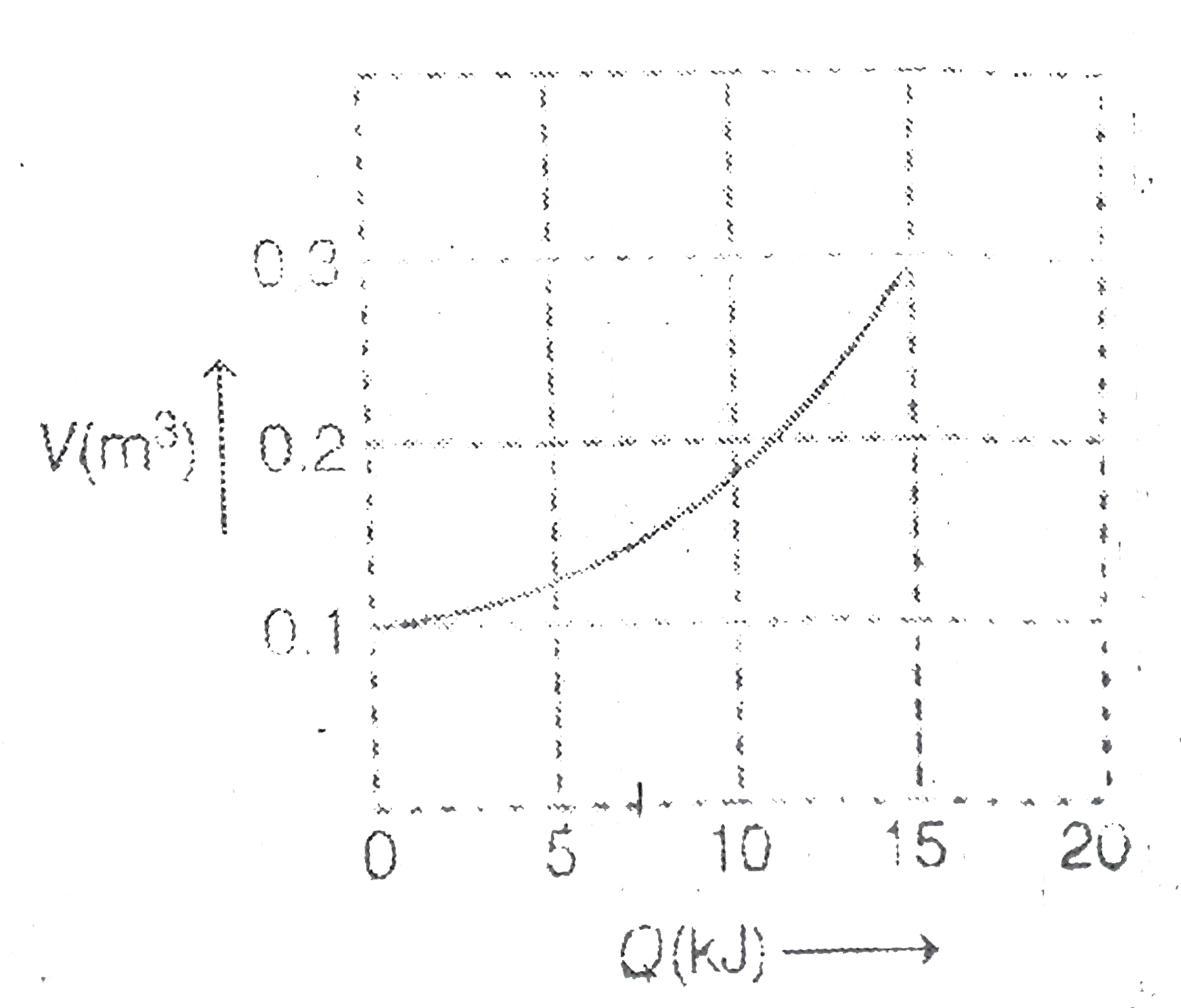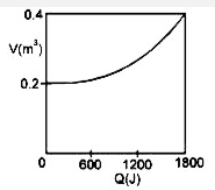Suppose 0.5 moles of an ideal gas undergoes an isothermal expansion as energy is added to it as heat Q. graph shows the final volume Vf versus Q. the temperature of the gas is (useIn3=1andR=253J/mol−K)
 Solution in Gujrati
Solution in Gujrati
293K
360K
386K
412K
The correct Answer is:B
Q=W=nRTlnVfVt
T=QnRlnVf/Vt=15000.5×25/3×ln3
=15000.5×25/3×1=360K
Topper's Solved these Questions
- GEOMETRICAL OPTICSBOOK - ALLEN CHAPTER - GEOMETRICAL OPTICSEXERCISE - EXERCISE -03
11 Videos
- GEOMETRICAL OPTICSBOOK - ALLEN CHAPTER - GEOMETRICAL OPTICSEXERCISE - ASSERTION-REASON
40 Videos
- GEOMETRICAL OPTICSBOOK - ALLEN CHAPTER - GEOMETRICAL OPTICSEXERCISE - EXERCISE -01
65 Videos
- CURRENT ELECTRICITYBOOK - ALLEN CHAPTER - CURRENT ELECTRICITYEXERCISE - EX.II
66 Videos
- GRAVITATIONBOOK - ALLEN CHAPTER - GRAVITATIONEXERCISE - EXERCISE 4
9 Videos
Similar Questions
Three liquids A,B and C having same specific heat and mass m , 2m and 3 m have temperature 20∘C,40∘C and 60∘C respectively. Temperature of the mixture when:
Column-IColumn-II(A)A and B are mixed(p)33∘C(B)A and C are mixed(q)52∘C(C)B and C are mixed(r)50∘C(D)A,B and C all three are mixed(s)46∘C(t)None
View SolutionStatement-1: A real gas behaves as an ideal gas at high temperature and low pressure .
Statement-2: Liquid state of an ideal gas is impossible.
View SolutionOn an X temperature scale, water freezes at −125.0∘X and boils at 375.0∘X. On a Y temperature scale, water freezes at −70.0∘Y and boils at −30.0∘Y. The value of temperature on X-scale equal to the temperature of 50.0∘Y on Y-scale is
View SolutionIn the Bohr's model of hy drogen atom, the electron moves around the nucleus in a circular orbit of radius 5×10−11m. Its time period is 1.5×10−16s. The current associated with the electron motion is:-
View SolutionAssertion : The difference in the value of acceleration due to gravity at pole and equator is proportional to square of angular velocity of earth.
Reason : the value of acceleration due to gravity is minimum at the equator and maximum at the pole.
View SolutionOne mole of an ideal gas at 27^(@) ,8.21 atm absorbs 420 cal of heat during a reversible isothermal expansion. Calculate the final volume (in litre) of gas. [Use: R=0.0821 " litre-atm"//"K-mole"]
View SolutionConsider isothermal expansion of 0.5 mole of an ideal gas when Q amount of heat is added to it. Following graph shows variation in volume V with Q. Find the temperature of the gas
(ln 3≈10,R=253J/mole−K)

View SolutionEntrolpy change in isothermal expansion work of one mole of an ideal gas from volume V1 and V2 is given by
View SolutionOne mole of a monatomic ideal gas undergoes an adiabatic expansion in which its volume becomes eight times its initial value. If the initial temperature of the gas is 100 universal gas constant 8.0, the decrease in its internal energy, in , is__________.
View SolutionEntropy change for an isothermal expansion of one mole of an ideal gas from volume V_(1) to V_(2) is :
View SolutionSuppose 0.825 mol of an ideal gas undergoes an isothermal expansion as energy is added to it as heat Q. If Fig. 21-30 shows the final volume V_f versus Q, what is the gas temperature? The scale of the vertical axis is set by V_(fs ) = 0.30 m^3 and the scale of the horizontal axis is set by Q_s = 1800 J .
View SolutionAn ideal gas is enclosed in a closed container of 0.0083m3 at 300 K temperature and pressure of 1.6×106 Pa. Find final temperature and pressure of the gas if 2.49×104 J heat is supplied to the gas. Neglect expansion of the container. R=8.3J mol−1K−1
View Solution0.5 mole of gas at temperature 300 K expands isothermally from an initial volume of 2.0L to final volume of 6.0L. What is the work done by the gas ? (R = 8.31 J mol^(-1) K^-(1)
View Solution0.5 mole of gas at temperature 300 K expands isothermally from an initial volume of 2.0L to final volume of 6.1L. How much heat is supplied to the gas?.
View SolutionConsider isothermal expansion of 0.5 mole of an ideal gas when Q amount of heat is added to it. Following graph shows variation in volume V with Q. Find the temperature of the gas ("ln "3~~10, R=(25)/(3)J//"mole"-K)
View Solutionएक मोल आदर्श गैस समतापीय प्रसार द्वारा गुजरता है। जब इसे Q ऊष्मा दी जाती है। दिया ग्राफ आयतन V तथा Q के मध्य दिखाया गया है। गैस का तापमान लगभग होगा : (R= 8.31 J/K.mole)

View Solution
